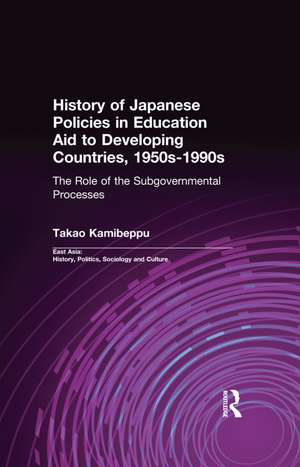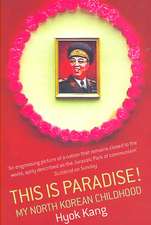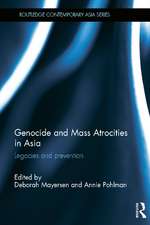History of Japanese Policies in Education Aid to Developing Countries, 1950s-1990s: The Role of the Subgovernmental Processes: East Asia: History, Politics, Sociology and Culture
Autor Takao Kamibeppuen Limba Engleză Paperback – 22 dec 2014
| Toate formatele și edițiile | Preț | Express |
|---|---|---|
| Paperback (1) | 426.94 lei 6-8 săpt. | |
| Taylor & Francis – 22 dec 2014 | 426.94 lei 6-8 săpt. | |
| Hardback (1) | 1000.51 lei 6-8 săpt. | |
| Taylor & Francis – 16 aug 2002 | 1000.51 lei 6-8 săpt. |
Din seria East Asia: History, Politics, Sociology and Culture
-
 Preț: 449.25 lei
Preț: 449.25 lei -
 Preț: 449.41 lei
Preț: 449.41 lei -
 Preț: 214.53 lei
Preț: 214.53 lei -
 Preț: 436.14 lei
Preț: 436.14 lei -
 Preț: 485.99 lei
Preț: 485.99 lei -
 Preț: 482.17 lei
Preț: 482.17 lei -
 Preț: 481.20 lei
Preț: 481.20 lei -
 Preț: 493.12 lei
Preț: 493.12 lei -
 Preț: 490.83 lei
Preț: 490.83 lei -
 Preț: 382.95 lei
Preț: 382.95 lei -
 Preț: 347.64 lei
Preț: 347.64 lei - 18%
 Preț: 276.29 lei
Preț: 276.29 lei -
 Preț: 430.43 lei
Preț: 430.43 lei - 14%
 Preț: 300.29 lei
Preț: 300.29 lei -
 Preț: 449.41 lei
Preț: 449.41 lei -
 Preț: 443.69 lei
Preț: 443.69 lei -
 Preț: 436.14 lei
Preț: 436.14 lei -
 Preț: 426.51 lei
Preț: 426.51 lei -
 Preț: 382.05 lei
Preț: 382.05 lei -
 Preț: 427.50 lei
Preț: 427.50 lei -
 Preț: 449.41 lei
Preț: 449.41 lei -
 Preț: 449.41 lei
Preț: 449.41 lei -
 Preț: 255.66 lei
Preț: 255.66 lei - 13%
 Preț: 311.51 lei
Preț: 311.51 lei -
 Preț: 432.12 lei
Preț: 432.12 lei - 18%
 Preț: 1167.01 lei
Preț: 1167.01 lei - 18%
 Preț: 1171.19 lei
Preț: 1171.19 lei -
 Preț: 436.14 lei
Preț: 436.14 lei - 18%
 Preț: 1001.84 lei
Preț: 1001.84 lei -
 Preț: 363.59 lei
Preț: 363.59 lei - 30%
 Preț: 768.30 lei
Preț: 768.30 lei
Preț: 426.94 lei
Nou
Puncte Express: 640
Preț estimativ în valută:
81.69€ • 85.30$ • 67.46£
81.69€ • 85.30$ • 67.46£
Carte tipărită la comandă
Livrare economică 15-29 aprilie
Preluare comenzi: 021 569.72.76
Specificații
ISBN-13: 9780415762304
ISBN-10: 0415762308
Pagini: 164
Dimensiuni: 152 x 229 x 10 mm
Greutate: 0.24 kg
Ediția:1
Editura: Taylor & Francis
Colecția Routledge
Seria East Asia: History, Politics, Sociology and Culture
Locul publicării:Oxford, United Kingdom
ISBN-10: 0415762308
Pagini: 164
Dimensiuni: 152 x 229 x 10 mm
Greutate: 0.24 kg
Ediția:1
Editura: Taylor & Francis
Colecția Routledge
Seria East Asia: History, Politics, Sociology and Culture
Locul publicării:Oxford, United Kingdom
Recenzii
"Kamibeppu's study provides a comprehensive account of how Japan developed education aid policies over the past five decades... we owe Kamibeppu a debt of gratitude for advancing the study of his nation's education aid policy." -- Education Review
Cuprins
Chapter 1 Introduction; Part I 1950s–1960s; Chapter 2 The 1950s: Post-War Recovery Efforts as the Foundation of Education Aid; Chapter 3 Japan’s Emergence as a Donor in the Early 1960s and the Development of Education Aid in the Late 1960s; Part II 1970s–1990s; Chapter 4 Subgovernmental Policymaking Processes and Dual Education Aid Systems in the 1970s and the 1980s; Chapter 5 The 1990s: Towards a “Normal” Relationship; Chapter 6 Conclusion;
























